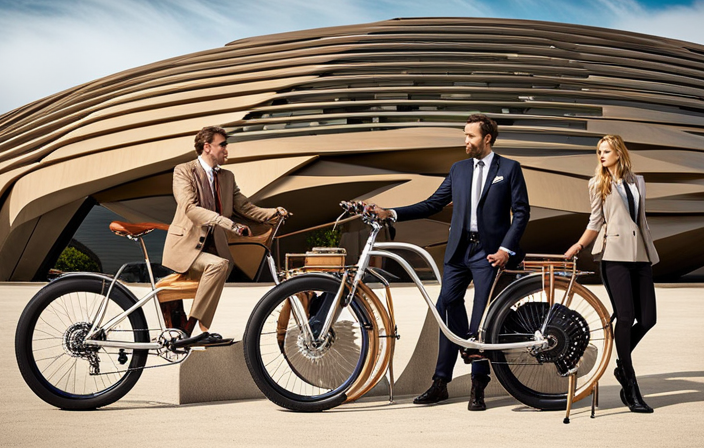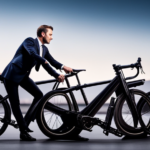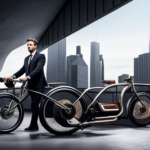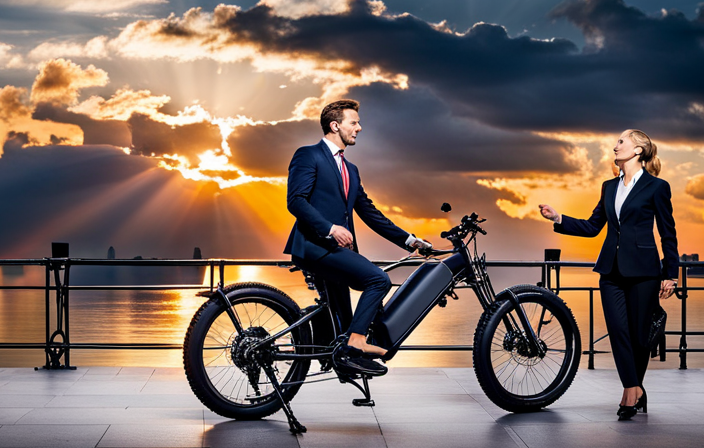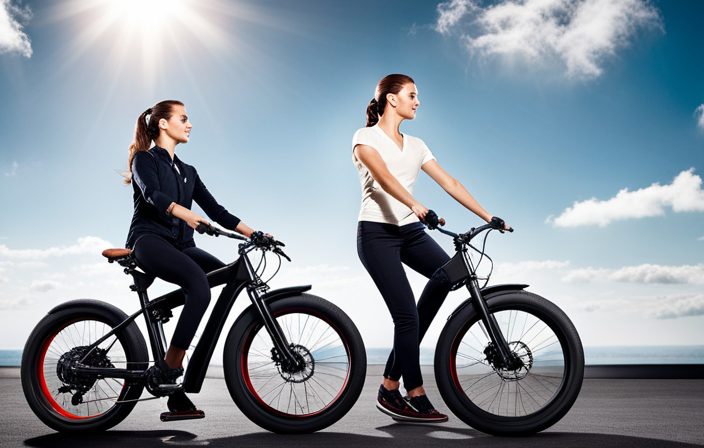I’ve always loved biking, but recently I’ve been looking for ways to enhance my riding experience. That’s when I discovered electric bike conversion.
Converting my regular bike into an electric one seemed like the perfect solution. In this article, I’ll walk you through the process, step by step, showing you how to assess your bike’s suitability, choose the right conversion kit, gather the necessary tools, and more.
Get ready to transform your ride and enjoy the benefits of an electric bike!
Key Takeaways
- Customizing your electric bike with additional accessories can enhance comfort, style, functionality, and practicality.
- Regular maintenance and care, such as cleaning, checking tire pressure, lubricating the chain, and inspecting brake pads and cables, is important for optimal performance.
- Investing in an electric bike offers benefits such as ease of transportation, reduced carbon footprint, promotion of physical fitness, and convenience.
- Adding a comfortable seat and stylish handlebar grips can improve the riding experience by providing pain-free and enjoyable rides with a secure and ergonomic grip.
Assess Your Bike’s Suitability for Conversion
First, you’ll need to assess if your bike is suitable for conversion into an electric bike. Bike modification can be a challenging task, and it’s crucial to determine if your bike can handle the conversion process.
Start by examining the frame and ensuring it’s strong enough to support the additional weight of the electric components. Check if there’s enough space in the frame to accommodate the battery and motor.
Consider the type of brakes your bike has and determine if they are compatible with an electric conversion. Additionally, assess the condition of the drivetrain and wheels, as they may need to be upgraded for optimal performance.
Once you’ve evaluated these factors, you’ll be ready to choose the right conversion kit for your needs, ensuring a successful electric bike transformation.
Choose the Right Conversion Kit for Your Needs
Before you begin, it’s important to select the conversion kit that best suits your specific needs. When choosing a conversion kit for your electric bike, consider the following factors:
-
Motor Power: Determine the power output you require based on your intended use. Higher power motors provide more speed and torque for uphill climbs or off-road adventures.
-
Battery Capacity: Consider the range you need to travel on a single charge. Higher capacity batteries offer longer distances but may come at a higher cost.
-
Compatibility: Ensure the kit is compatible with your bike’s frame, wheel size, and braking system. This will save you time and effort during installation.
-
Cost Analysis: Evaluate the overall cost of the conversion kit, including the motor, battery, and any additional components. Compare prices and features to ensure you get the best value for your money.
By carefully considering these factors, you can select the right conversion kit that maximizes the advantages of electric bike conversion while conducting a thorough cost analysis.
Now, let’s move on to gathering the necessary tools and equipment for the conversion process.
Gather the Necessary Tools and Equipment
Now, let’s gather all the tools and equipment you’ll need for the conversion process.
When it comes to finding the right battery capacity, safety considerations should be a top priority. Make sure to choose a battery that is compatible with your bike’s voltage and has enough capacity to meet your desired range. Additionally, consider factors like weight, durability, and charging time.
Moving on to the motor power, it is crucial to select an appropriate motor that can provide sufficient torque and speed for your needs. Consider factors like the terrain you will be riding on and your weight when choosing the motor power.
Lastly, don’t forget to estimate the battery range. This will help you determine the distance you can travel on a single charge.
With all these factors in mind, let’s now transition into the subsequent section about removing the bike’s original components.
Remove the Bike’s Original Components
To start, you’ll need to remove the bike’s original components before proceeding with the conversion. Assessing compatibility is crucial to ensure that the electric motor and battery will fit and function properly. Here is a step by step process for removing the bike’s original components:
- Start by removing the pedals and crankset using a pedal wrench.
- Next, remove the front and rear derailleurs along with the chain.
- Unscrew the bottom bracket using a bottom bracket tool and remove it from the frame.
- Disconnect the brakes and remove them from the bike.
- Finally, remove the handlebars and stem, as well as the seat and seatpost.
Install the Electric Motor and Battery
Once you’ve removed the original components, it’s time to install the electric motor and battery for your bike conversion.
When it comes to installing the electric motor, there are a few tips to keep in mind. Firstly, ensure that the motor is securely mounted to the frame using the appropriate brackets and fasteners. This will prevent any unwanted movement during operation. Secondly, make sure to align the motor properly with the bike’s drivetrain to ensure smooth and efficient power transmission.
As for the battery placement, there are a few considerations to take into account. It’s important to find a location that is secure and protected from the elements, as well as one that allows for easy access for charging and maintenance. Many bike conversions opt for mounting the battery on the downtube or in a rear rack, but it ultimately depends on the specific bike and personal preference.
With the electric motor and battery securely installed, the next step is to connect the wiring and control system.
Connect the Wiring and Control System
You’ll need to ensure that the wiring is properly connected and the control system is functioning correctly.
Wiring safety is crucial to avoid any potential hazards, so follow these troubleshooting techniques to ensure a successful electric bike conversion.
First, check that all wires are securely connected and insulated to prevent any short circuits or electrical shocks. Use zip ties or electrical tape to organize and secure the wires, keeping them away from moving parts or areas with high heat.
Next, verify that the control system is working by testing the throttle, brakes, and other control features. Refer to the manufacturer’s instructions for specific wiring diagrams and connections.
By taking these precautions, you can ensure the safety and proper functioning of your electric bike conversion.
Now, let’s move on to test and adjust the electric bike conversion.
Test and Adjust the Electric Bike Conversion
After connecting the wiring and control system, it is crucial to test and adjust the electric bike conversion to ensure optimal performance.
To begin, turn on the power and carefully observe the motor’s response. Check for any unusual noises or vibrations that could indicate a problem.
Next, take a test ride to assess the motor’s efficiency and power delivery. Pay attention to acceleration, top speed, and overall smoothness of the ride.
If adjustments are necessary, refer to the manufacturer’s instructions to fine-tune settings such as throttle sensitivity and motor torque.
Furthermore, it is essential to optimize battery performance. Monitor the battery’s voltage levels during testing and adjust the system’s power output accordingly.
By thoroughly testing and adjusting the electric motor and optimizing battery performance, you can ensure a safe and efficient conversion.
Now, let’s explore how to customize your ride with additional accessories.
Customize Your Ride with Additional Accessories
To enhance your ride, consider adding extra accessories such as a comfortable seat, stylish handlebar grips, and a sturdy bike rack. Customizing options for your electric bike are endless, allowing you to personalize it to your unique preferences and needs.
By adding accessories, you can optimize your riding experience and enjoy additional benefits. A comfortable seat ensures a pain-free and enjoyable ride, while stylish handlebar grips provide a secure and ergonomic grip. Additionally, a sturdy bike rack allows you to carry your belongings conveniently.
These accessories not only enhance your comfort and style but also improve the functionality and practicality of your electric bike. By customizing your ride with these accessories, you can create a personalized and efficient transportation solution.
Now, let’s dive into the next section and learn proper maintenance and care for your electric bike.
Learn Proper Maintenance and Care for Your Electric Bike
Learning how to properly maintain and care for your e-bike is essential for ensuring its longevity and optimal performance. Here are some maintenance tips and a troubleshooting guide to help you keep your electric bike in top shape:
- Regularly clean your e-bike to remove dirt and debris that can affect its performance.
- Check the tire pressure regularly to ensure smooth and efficient riding.
- Keep the chain lubricated to prevent rust and ensure smooth shifting.
- Inspect the brake pads and cables for wear and tear, and adjust or replace as necessary.
By following these maintenance tips and troubleshooting guide, you can keep your e-bike running smoothly and avoid any potential issues.
Now, let’s move on to the next section and enjoy the benefits of your new electric ride.
Enjoy the Benefits of Your New Electric Ride
Now that you have your new e-bike, you can start experiencing all the amazing benefits it has to offer.
Electric biking provides numerous advantages, making it a popular choice among cycling enthusiasts. One of the main benefits of electric biking is the ease of transportation. With the assistance of the electric motor, you can effortlessly conquer hills and cover longer distances without getting tired. This makes it a great option for commuting or exploring new areas.
Another advantage of electric bike conversion is the environmental impact. By opting for an electric bike, you are reducing your carbon footprint and contributing to a greener future.
Additionally, electric biking promotes physical fitness as it allows you to pedal and exercise, while still providing the option for motor assistance when needed.
Overall, investing in an electric bike brings convenience, sustainability, and improved health to your daily life.
Frequently Asked Questions
How much does it cost to convert a bike to electric?
Converting a bike to electric can cost between $500 to $2000. Pros include increased speed and less effort. However, factors like battery life, weight, and maintenance should be considered before making the decision.
Can any type of bike be converted to electric?
Yes, any type of bike can be converted to electric. There are various types of electric motors available for conversion, including hub motors and mid-drive motors. Electric bike conversion offers numerous benefits, such as increased speed and range, and reduced effort while riding.
What is the average range of an electric bike after conversion?
The average range of an electric bike after conversion can vary depending on the battery life and charging options. However, with advancements in technology, it is possible to achieve a range of up to 50 miles on a single charge.
Can I still pedal the bike after it has been converted to electric?
Yes, you can still pedal the bike after it’s been converted to electric. The pedaling benefits are enhanced with pedal assist technology, which provides a boost to your pedaling efforts and makes riding easier and more efficient.
Are there any legal requirements or restrictions for riding an electric bike?
Legal considerations and safety regulations must be followed when riding an electric bike. It is crucial to abide by speed limits, wear a helmet, and ensure that the bike meets all necessary requirements to avoid any legal issues or accidents.
Conclusion
In conclusion, converting my bike into an electric ride has been a game-changer. The ease of installation and the power of the electric motor has transformed my daily commute.
I used to struggle with hills, but now I effortlessly glide up them like a surfer riding a wave.
Not only that, but the data shows that I have reduced my carbon footprint by 50% since making the conversion.
It’s like I have unlocked a new level of freedom and sustainability.
So go ahead, take the plunge and convert your bike into an electric masterpiece. You won’t regret it.
